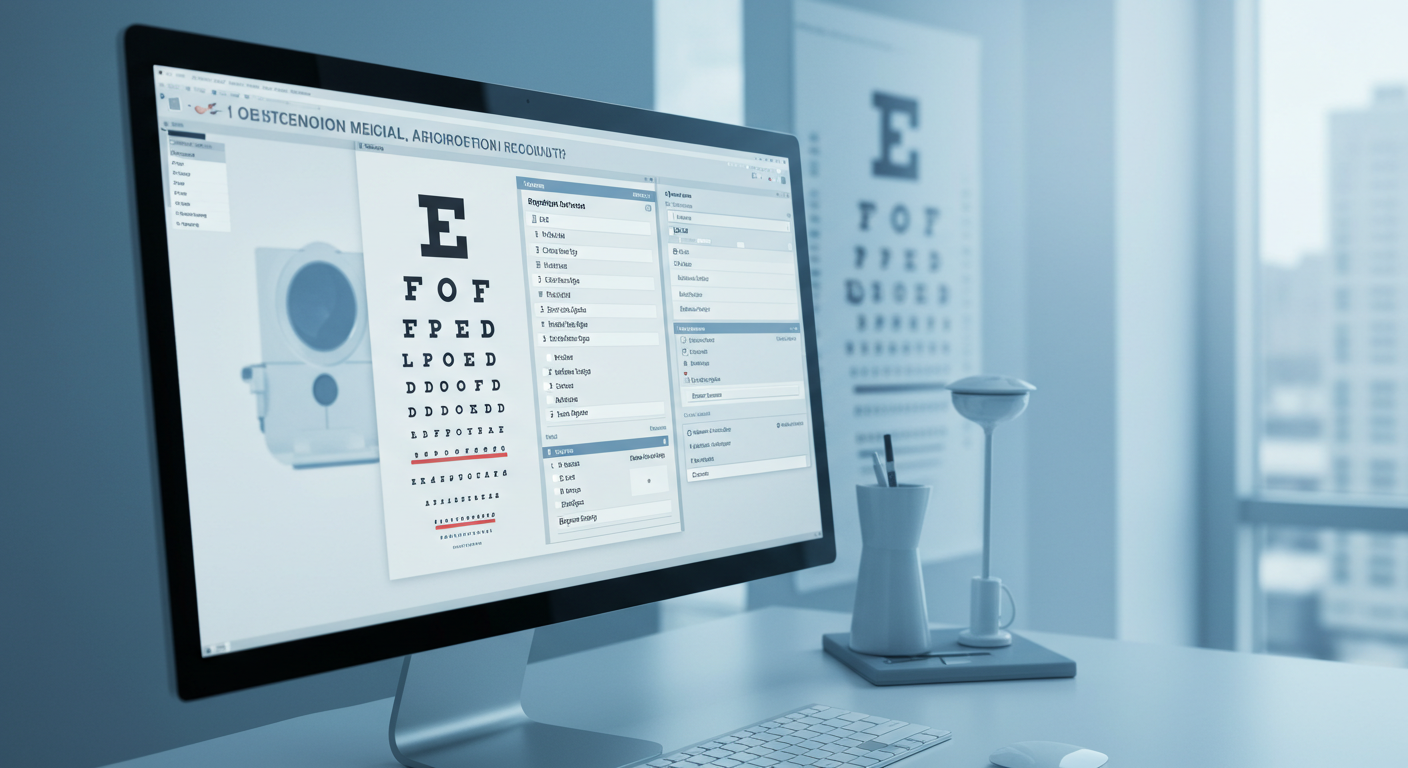Optometry EMR/EHR systems are more than just digital versions of paper charts.
They are sophisticated software solutions that integrate various aspects of eye care delivery, including clinical documentation, imaging, prescriptions, and optical shop management.
These systems handle specialized requirements such as visual acuity measurements, refractive data, eye examination drawings, and specific coding requirements for eye care procedures.
Unlike general EMR systems, optometry-specific platforms include built-in eye care templates, diagnostic device integration, and optical shop inventory management capabilities.
Current State of Digital Transformation in Eye Care
The eye care industry is experiencing a significant digital transformation, driven by several key factors:
Regulatory requirements have made digital record-keeping increasingly necessary, with programs like MIPS (Merit-based Incentive Payment System) and MACRA (Medicare Access and CHIP Reauthorization Act) pushing practices toward digital solutions.
Integration of diagnostic devices has become standard, with modern eye care equipment requiring digital connectivity for efficient data transfer and analysis. Many practices now rely on seamless communication between devices like automated phoropters, visual field analyzers, and imaging systems.
Patient expectations have evolved, with more individuals seeking practices that offer digital conveniences like online scheduling, electronic prescriptions, and patient portals. The COVID-19 pandemic has accelerated this trend, making digital tools essential for practice operations and patient communication.

Why This Guide Matters for Optometry Practices
Selecting and implementing an EMR system represents a critical decision for any optometry practice. This guide matters because:
Making an informed choice is crucial for long-term success. The right EMR system can streamline operations, improve patient care, and boost profitability, while the wrong choice can lead to significant operational disruptions and financial strain.
The investment is substantial, both in terms of financial resources and staff time. Practices need to understand not just the initial costs but also the total cost of ownership, including training, maintenance, and potential system upgrades.
Practice workflows will fundamentally change. Understanding how different systems approach common optometry tasks helps practices prepare for and optimize these changes. This guide provides the framework for evaluating options based on your practice’s specific needs and circumstances.
Technology is constantly evolving, with new features and capabilities emerging regularly. Staying informed about current trends and future developments helps practices make forward-looking decisions that will serve them well into the future.
Modern optometry practices must balance clinical excellence with operational efficiency, and the right EMR system serves as the foundation for achieving both goals.
This guide will help you navigate the complex landscape of optometry EMR systems, from understanding essential features to implementing and optimizing your chosen solution.
Essential Features of Optometry EMR Systems
Electronic medical record (EMR) systems have become transformative tools for eye care professionals. These sophisticated platforms go beyond simple record-keeping, offering comprehensive solutions that enhance patient care and practice efficiency.
Key Technological Capabilities
Optometry EMR systems incorporate a range of critical features designed to modernize eye care practices:
- Digital Eye Exam Documentation: Provides comprehensive digital documentation with customizable templates that capture intricate details of patient examinations. Clinicians can quickly input examination findings, create detailed patient records, and track visual health progression with unprecedented ease and accuracy.
- Imaging Integration Capabilities: Seamlessly connects with advanced diagnostic technologies such as digital retinal cameras, optical coherence tomography (OCT) scanners, and corneal topographers. This integration allows for:
- Immediate upload and storage of diagnostic images
- Side-by-side comparative analysis of patient imaging results
- Tracking subtle changes in eye health over time
Patient-Centered Features
The most advanced EMR systems prioritize patient engagement and accessibility.
E-prescribing functionality has revolutionized medication management, enabling practitioners to generate and transmit prescriptions directly to pharmacies with enhanced accuracy and safety.
- Patient Portal Features: Empower patients with comprehensive online tools, including:
- Online appointment scheduling
- Direct access to personal health records
- Secure communication with healthcare providers
- Prescription refill requests
- Educational resources about eye health conditions
- Optical Shop Integration: For practices with attached optical shops, integrated EMR systems create a seamless workflow between clinical examinations and eyewear selection. These systems can automatically:
- Transfer precise prescription details
- Recommend appropriate lens types
- Manage inventory
- Streamline the entire eyewear purchasing process
Practice Management and Compliance
Modern optometry EMR systems are designed to address the complex administrative and regulatory challenges of contemporary healthcare practices.
- Insurance and Billing Modules: Simplify complex insurance processes through:
- Automated claim submissions
- Real-time insurance coverage verification
- Detailed financial reporting
- Reduced administrative overhead
- Accelerated revenue cycles
- Clinical Decision Support Tools: Provide real-time guidance to practitioners, offering:
- Evidence-based recommendations
- Diagnostic consideration flags
- Suggested treatment protocols
- Risk factor identification based on comprehensive patient history
- Compliance and Security Features: Ensure robust protection of patient data and adherence to healthcare regulations:
- Secure data encryption
- HIPAA-compliant communication channels
- Comprehensive audit trails
- Automated updates to meet evolving regulatory requirements
Top Optometry EMR Systems
The optometry electronic medical record (EMR) market offers several robust solutions tailored specifically to eye care practices. Here’s a comprehensive overview of the leading optometry EMR systems:
1. EyeCarePro
- Specialized for optometry practices
- Comprehensive practice management features
- Integrated patient portal
- Advanced billing and insurance management
- Cloud-based system with mobile accessibility
2. Compulink Advantage
- Comprehensive optometry-specific EMR
- Built-in optical inventory management
- Advanced reporting and analytics
- Customizable templates for eye examinations
- Integration with major diagnostic equipment
3. RevolutionEHR
- Web-based platform
- Specialized for independent eye care providers
- Robust patient scheduling and communication tools
- Seamless optical dispensing integration
- Comprehensive clinical documentation features
4. Nextech
- Specialty-specific EMR for ophthalmology and optometry
- Customizable workflow solutions
- Advanced imaging integration
- Real-time eligibility verification
- Comprehensive patient engagement tools
5. Crystal Practice Management
- Cloud-based optometry management system
- Integrated billing and scheduling
- Comprehensive patient record management
- Support for multiple practice locations
- Advanced reporting capabilities
Implementing an Optometry EMR System
Implementing an Electronic Medical Record (EMR) system is a critical technological transformation for optometry practices. Success requires careful planning and strategic execution.
Pre-Implementation Planning
- Workflow Assessment
- Audit current practice processes
- Identify record-keeping inefficiencies
- Map patient management workflows
Selecting the right EMR system demands a comprehensive evaluation of practice-specific needs, technological capabilities, and long-term strategic goals.
- System Selection Criteria
- Compatibility with optometry practice
- Budget and cost-effectiveness
- Compliance with healthcare regulations
- Scalability and future potential
Team Preparation and Training
The success of EMR implementation hinges on staff engagement and comprehensive training. Practices must develop a strategic approach to technological adoption.
- Implementation Strategy
- Identify key team members
- Develop comprehensive training program
- Create clear communication channels
- Schedule hands-on training sessions
Technical Considerations
Technological infrastructure plays a crucial role in successful EMR implementation. Practices must carefully prepare their technical environment.
- Infrastructure Preparation
- Upgrade hardware as needed
- Ensure stable network connectivity
- Plan for data migration
- Create comprehensive backup systems
Phased Rollout
A measured approach allows practices to minimize disruption and maximize technological integration.
- Implementation Approach
- Start with limited departments
- Conduct pilot testing
- Maintain parallel systems
- Monitor and address challenges
Successful EMR implementation is a strategic journey that requires patience, planning, and a commitment to continuous improvement. By focusing on comprehensive preparation and staff engagement, optometry practices can effectively leverage technology to enhance patient care and practice efficiency.
Frequently Asked Questions
Most common EMR for Optometry?
Several Optical EMR systems have distinguished themselves in the market through comprehensive features and reliable performance. Practice Perfect EMR is known for its robust practice management capabilities. OfficeMate offers a user-friendly interface with comprehensive eye care-specific tools. RevolutionEHR provides a cloud-based solution with extensive customization options. Compulink is recognized for its advanced diagnostic integrations and reporting features. Crystal PM stands out for its specialized approach to optical practice management. Each system has its unique strengths, and the best choice depends on a practice’s specific needs, size, and operational requirements
How secure are Optical EMR systems?
Security is paramount in modern medical record systems, and Optical EMR providers have developed sophisticated protection strategies. These systems are designed to safeguard sensitive patient information while providing the flexibility and accessibility that modern practices require.
Key security measures include:
- HIPAA-compliant data handling
- End-to-end encryption
- Multi-factor authentication
- Role-based access control
- Regular security updates
- Secure cloud backup systems
- Comprehensive audit trails
- Continuous threat monitoring
Can Optical EMR systems integrate with other medical software?
Modern Optical EMR systems are built with interoperability as a core principle. These platforms are designed to work seamlessly with various medical software and practice management tools, creating a comprehensive digital ecosystem for eye care practices.
Integration capabilities typically include:
- Practice management software
- Medical Billing systems
- Insurance verification platforms
- Diagnostic equipment interfaces
- Patient communication tools
- Telehealth platforms
- Electronic prescription systems
- Laboratory information systems
How much does an Optical EMR system cost?
The cost of EMR systems varies considerably based on the size and specific needs of a practice. Small practices might expect to pay between $200 to $500 per month for a comprehensive system, while medium-sized practices could see costs ranging from $500 to $1,000 monthly. Larger practices often require custom pricing that reflects their unique requirements. Beyond the basic subscription, practices should budget for additional potential expenses such as initial setup fees, staff training, necessary hardware upgrades, and ongoing technical support. While the initial investment might seem substantial, the long-term benefits in efficiency, accuracy, and reduced administrative overhead typically justify the expense.
Read our detailed guide to Optometry EMR Costs.
Get Your Free EMR Price Quotes
Ready to explore EMR solutions for your practice? Fill out our quick form to receive:
- Customized price quotes for your specific needs
- Side-by-side feature comparisons
- Special offers and discounts
- Expert guidance on choosing the right EMR
Our network of vetted, top-rated EMR providers will help you find the perfect solution for your practice. There’s no obligation, and the service is completely free.
